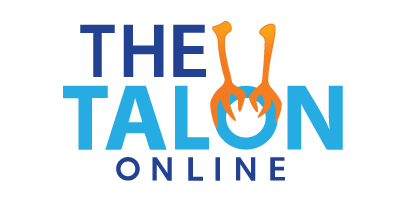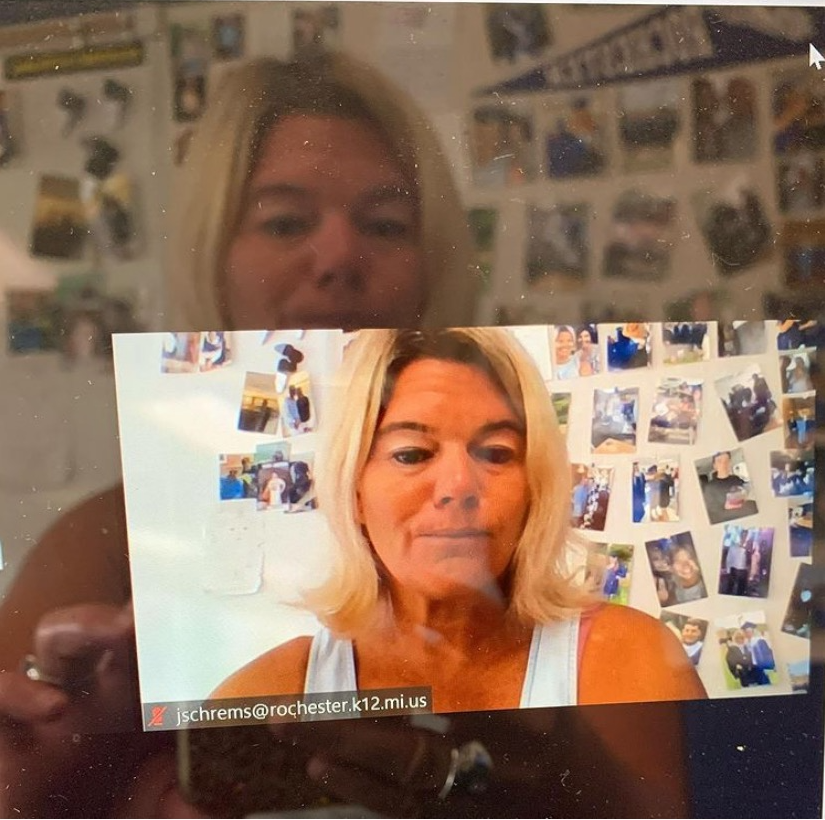Teaching in a pandemic: Unpacking educators’ exhaustion, growth, uncertainty, fulfillment
“Teachers are working really hard to keep students’ educational experience the best it can be”
January 8, 2021
Roaming Rochester High School amid a global pandemic, one would find empty locker banks which once sheltered students, vacant collabs which once served as hubs for group work, spacious hallways which once were crowded beyond belief, and unattended classrooms which were once teachers’ second homes.
This pandemic has brought about challenges for everyone imaginable, including educators. Many are working hard day and night to achieve ideals for their students under less than ideal conditions while still trying to balance personal life and maintain positivity.
Mr. Robert Byrd is a math teacher at Rochester high School who is co-chair of the district’s Remote Learning Subcommittee. He has worked alongside leaders to keep students and staff safe amidst a global pandemic while meeting kids’ educational needs. Between his duties as co-chair, preparing note videos for his students, creating lesson plans, meeting with students, and other responsibilities, he often works ten to fourteen hours days, seven days a week..
“I am an absolute mess most days,” Mr. Byrd said. “I do my best work when people at my house are sleeping, so I also feel compelled to work at those times as well. I know that I am not practicing self-care, because I absolutely do not have time to do so – it is too busy of a time. About every other week, the stress builds up to the point to where I break down and either just pass out of exhaustion or I get really angry.”
As an AP Calculus and Algebra 2 teacher, Mr. Byrd was familiar with examining written work and providing his students with feedback. With remote learning, this has become a challenge. He has adopted a check-in system in which about once a week, students have a short assignment to complete. They submit a photo of it, and Mr. Byrd reviews each one thoroughly and comments on the work.
“It is really hard to give feedback in the ways that I am accustomed to,” he explained. “I am trying to figure out new ways and explore ways I wasn’t as familiar with in order to make the students’ learning process easier.”
Because of the shift of students to virtual learning, some teachers were displaced. This means they were moved to a different school in the district or to the Virtual Campus. Ms. Dionysia Kefallinos was amongst this group as a former RHS English teacher turned Adams High School English teacher.
“I was notified that I would be moving to Adams before the beginning of the school year,” explained Ms. Kefallinos. “I was surprised and sad to be leaving RHS, but everyone at Adams and in the district was very supportive and welcoming, which made the transition much easier.”
Math teachers face unique challenges in remote teaching compared to science teachers who face unique challenges compared to english teachers and so on. For example, science classes are extremely hands-on with activities like labs and demonstrations. Finding a way to include these aspects of class in online learning has been a major priority of science teachers.
“I have had to redesign everything including labs to fit the digital format,” science teacher Mrs. Erin Slomka said. “I have also had to teach myself other platforms to try and make class time collaborative or to make testing rigorous and authentic.”
Elective classes are still embedded in students’ schedules, from courses like jazz band to aerobics to 3-D art. Mrs. Jessica Huvaere is an art teacher who has had to reformat all her classes to work in a digital environment.
“I have had to completely rethink the way I think about teaching students to create art in their homes, using the materials and supplies that they have,” she explained. “I’m sure most teachers can relate, but basically I’ve had to recreate classes I have taught for 15 years so that the projects and assignments are applicable from home… I have learned many new methods for sharing my love for art and creating with my students and in many ways have grown as a teacher.”
Different educators structure the week’s two 90 minute class periods in various ways. Some spend the entirety of the block lecturing on Zoom, others give instruction and allow students the remaining time to work, and others combine the two.
Mr. Byrd typically gives his students the first 30 minutes of class to complete that class time’s expectations, which he posts at the start of the period on Google Classroom. Students are also provided with a calendar that outlines which lessons they should have accomplished by a certain date to stay on track.
“I have ‘flipped’ all of my classes, so that the lesson occurs within an asynchronous video,” Mr. Byrd said. “This gives us more time in our class time to talk about mathematics. Then, when we meet via Zoom, we will spend between 30-60 minutes together in various activities. I very often show them our calendar so they know what to do. Then the day could look different. Some days are just question days. Some days are spent in a Slides activity. Some days are spent in a Kahoot environment.
English teacher Mrs. Jennifer Schrems attempts to mimic what a class period in the building would be like.
“For example, I may teach a lesson and model an assignment then give individual time to work allowing kids to check in with me or conference with me ‘out in the hall,’” she explained. “I try to mix up instruction time with independent and group work time.”
Just like how not every school day pre-COVID looked the same, not every day in Zoom classes look the same. The way teachers structure each class period varies based on their lesson plans for them.
“Some days are the whole time and we are working between lectures/whole class work, some days I have group work, and some days I have shorter Zoom classes, but students are working independently,” Ms. Kefallinos said. “The variety is similar to how my classroom was before, but now just in an online format.”
As an art teacher, Mrs. Huvaere teaches six different classes to students of all grade levels. A common thread in all her classes, however, is collaboration and constructive critique, which is challenging to conduct with each student in their own homes.
“I have found jamboard in almost all classes has been an amazing way for me and my students to connect, easily share artwork and constructively critique each other’s work,” she commented.
Many educators all over the nation double as parents in their own homes, which leads to another obstacle with teaching from home. With young kids who need constant attention and school-aged ones who may need help with their own Zoom classes. Mrs. Slomka has a son and a daughter, and in order to be able to teach from home, she put her son in daycare full time. Her daughter is in elementary school and spends her day conducting classwork and meeting with her teacher from home.
“Our strength as a family has been the number one reason why we keep succeeding,” Mrs. Slomka said. “My husband and I are both teachers and we are very clear and direct with each other if we need to trade off on watching our kids so that we can get more work done in the evenings and during the weekend.”
Mr. Byrd has two children and often relates to Mrs. Slomka’s struggles and circumstances.
“My oldest daughter has taken to remote learning pretty well,” he explained. “My youngest daughter struggles with homework completion and motivation. My wife has also worked from home in large stretches, so it is weird for all of us to be ‘at work’ while we are home all day. While there are positives to all of us being home – guaranteed family dinners every night and more consistent game/movie time in the evenings being two of those few positives – it is incredibly awkward at times.”
Amidst all the craziness and uncertainty of this pandemic for parents, educators, students, and all people is calmness, peace, and growth. After all, there is always an eye in a hurricane.
“I have learned how resilient and flexible we all are and to slow down- this has been huge,” Mrs. Huvaere said. “I have a big, busy family and previously felt like we lived out of our car always on the go. The pandemic has brought our lives to a halt and we have slowed down tremendously. I think we have all learned to appreciate the smalls things and give God thanks and praise daily for our health and time with loved ones.”
Although teaching remote is not the way most teachers hoped to spend the school year, it has brought to light new methodology, programs, and management.
“I am playing with the idea of keeping my ‘flipped’ classroom when we return to full-time in-person learning,” Mr. Byrd said. “I can see the benefits of using that class time on other activities instead of dedicated notes time. I am also learning more about what AP Classroom can do for me in the appropriate times. Finally, I really want to find ways where I don’t have to look at daily homework, and I will be able to play with some ways to get that done this year.”
Ms. Kefallinos finds herself in a similar situation:
“I have learned new ways of carrying out instruction and giving feedback that I fully plan on using when we are back in person, so it has definitely been a growth for my teaching experience/repertoire. I have also just been reminded that our students are amazing and resilient, and will rise to any challenge. I am very proud of all of our kids,” Ms. Kefallinos said.
Students and teachers alike have had to make adjustments to their schedules and outlooks because of this unprecedented situation. After almost nine months of remote learning, they are beginning to get into the swing of things.
“I think [students’] feelings about it change each day,” Mrs. Schrems said. “I know mine sure do. Some days it feels like everything is clicking and other days, it’s messier, but overall it is going well all things considered. I make sure my kids know that I am there for them and make sure they know there isn’t anything they can tell me that will make me love them less.”
Mrs. Slomka emphasized student feedback about their understanding of the material and potential struggle areas. Without being able to see their facial expressions and reactions due to most cameras being turned off, it is challenging to access the lesson’s delivery. Zoom school has decreased her students’ engagement in discussion as well.
“I stay up until midnight or later and get up at 5:30 am,” she said. “I am usually exhausted and I feel unsure about my impact of teaching because I don’t receive much feedback from my students during class… Students showing up and participating are the most important factor in their success.”
Michigan teachers and students all dipped their toes in remote teaching and learning back in the spring when the pandemic first hit the United States. Much has changed for many educators over the past few months. They explained that it used to feel as if they were drowning in the unknown, but they now are able to swim- more equipped to handle the pandemic.
“I can’t stress this enough… I feel so much more focused, and planned, and organized than I did in March,” Mr. Byrd said. ‘Sometimes, that adds to my stress, because even though I have a better idea of what needs to happen, making those plans happen is so much more difficult than in our in-person setting.”
Mrs. Schrems agreed:
“It feels way more like ‘real school.’ Last spring, we were all trying to figure it out, but our district has worked hard to get where we are. I am proud to be a Rochester teacher and I am proud of my students for showing up and giving their best.”
Many teachers recognize the difficulties their adolescent students are facing right now. Their goal is for them to truly understand the material and feel a sense of accomplishment and ability.
“I am always pleasantly surprised as to how much work my students are doing,” Mr. Byrd said. “It is harder for me to gauge because I don’t have that daily interaction to really look at work and see how they are doing. I really hope that they can see that their teachers are working really hard to keep their educational experience the best it can be.”
Mr. Byrd has been vocal regarding his pride in being a Rochester Community Schools teacher as well as his support of both the state’s and the district’s response to COVID-19 and its relation to schools.
“I really feel that our district has done everything they can to make sure everyone’s voice is heard. I know that sometimes it might not feel that way from different perspectives, and I know that it is impossible to make everyone happy. I am comforted in knowing that every decision that is made is based on what is best for our students and our community, and that is all that can be expected… I can’t wait to get back into a school building, and I can’t wait to have school feel more ‘normal.’ However, we have a responsibility to keep our students and community safe and local and state governments will continue to do what they need to do to ensure that safety.”
Working from home does have its perks. May it be the lack of a commute or the ability to see family throughout the day, seeing the moonlight in the dark night sky is important.
“My dog Paddy loves that I am home, Mrs. Schrems said. “I also enjoy being able to see my son Brady for long periods of each day.”
Prior to COVID, many teachers attempted to keep their personal lives out of the classroom, but with conducting Zoom classes from home, this has become close to impossible, which may not always be a bad thing.
“I like how students now get a glimpse of my home life and am much more comfortable letting students see a mess in my zoom background or hear an occasional crying child than I was in the spring, showing them the real life side of their teacher,” Mrs. Huvaere explained.
For many, teaching is more than just educating students on the curriculum and helping them reach state standards. It is about building relationships with them in order to better reach them. Conducting class over Zoom raised a concern: Would these relationships still occur?
“At times, it makes me sad that I am not able to have the rich and organic conversations with my kids that usually happen in between classes or at the last few minutes of class,” Mrs. Schrems said. “I try to utilize the breakout rooms so I get one-on-one time with each student.”
Mrs. Huvaere, amongst an abundance of teachers, ensure to make conversation with students and allow them some social time to somewhat mimic the happenings of a typical classroom.
“I try to always ask my students how they are feeling and what they are looking forward to. It’s important to stay social and connected and remain hopeful for the future… I miss seeing my students in person so much,” she said. ‘I very much look forward to seeing their faces again!”
With the constant changes to every aspect of life and the battles educators are facing attempting to do their jobs amidst a global pandemic, many believe it is significant to maintain a positive and hopeful attitude.
“I think I always knew this, but the pandemic has reaffirmed that life is fragile and precious,” Mrs. Schrems said. “Do your best each day and be kind to others.”






